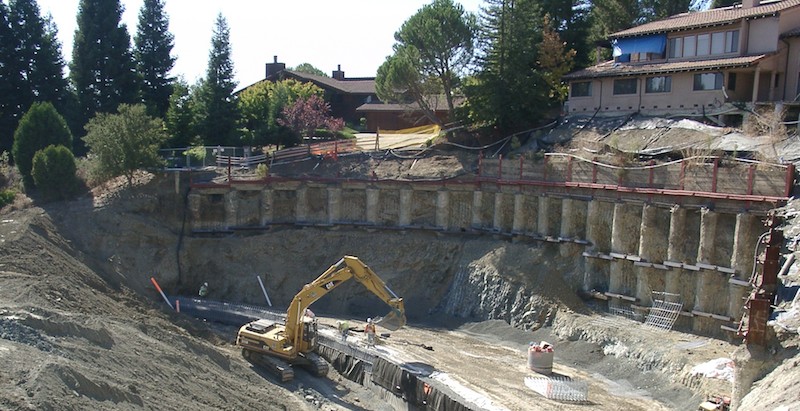By Christopher Wilhite, chief engineer and co-owner at Engineered Soil Repairs, Inc.
As we approach the rainy season, it’s time to start paying attention to what rain can mean for the Bay Area. While rain may ease our persistent drought, it can also cause issues for Bay Area residents, especially after so many dry years. One consequence of rain after a drought is the increased likelihood of landslides—a familiar problem in this beautiful but hilly region. Debris flows (a type of landslide more commonly known as “mudslides”) have caused millions of dollars worth of property damage in the Bay Area. More importantly, people can and have died as a result of these fast-moving landslides. Bay Area residents: it’s time to get informed and prepared. To start the conversation, we asked Christopher Wilhite, chief engineer at Engineered Soil Repairs, Inc., to explain precisely what causes landslides.

Engineered Soil Repairs, Inc. repairs damage from a landslide in Lafayette. Photo: Engineered Soil Repairs, Inc., 2016
What causes landslides?
Ninety-nine percent of the time, landslides are caused by water affecting the stability of a slope. There are two basic forces that determine slope stability:
1. Driving Force. This force wants to push the soil mass downhill. It’s a function of the weight of the soil and the steepness of the slope.
2. Resisting Force. This force tries to keep the soil from moving downhill. It’s the internal friction between the soil mass that wants to slide and the mass of soil below, which is stable.
When the driving force is greater than the resisting force, you have a landslide.
Why does water cause landslides?
When water is introduced to the soil (i.e. from rain or a water pipe break), it fills the tiny void spaces between soil particles and adds weight to the soil. This weight increases the driving force. At the same time, water reduces the resisting force by reducing friction. Essentially, the soil gets slick at the point of contact between the soil mass that wants to slide and the soil mass that’s stable. When certain types of soil become saturated, they lose all strength and behave like a liquid, flowing down the slope. This is what’s known as a mudslide.
What else can cause landslides?
1. Adding weight to the top of a slope. Example: A property owner increases the driving force by dumping a large mound of heavy soil at the top of a slope. The driving force overpowers the resisting force, resulting in a slide.
2. Removing soil from the bottom of the slope. Example: A property owner who has dug at the bottom of a slope for a retaining wall lets it sit for too long. The soil above the digging area becomes unstable, which decreases the resisting force and results in a slide.
Good to know
Sometimes, there are natural subsurface features that make slopes more prone to sliding, including:
1. A thin, clay seam below ground and between soil layers. The clay gets slick when wet and destabilizes the slope.
2. Soil may have a weak layer that’s more easily sheared than the soil above and below it.
3. On steeper slopes, the interface between the soil and the bedrock below can become a natural slide plane.
